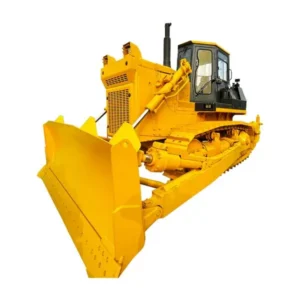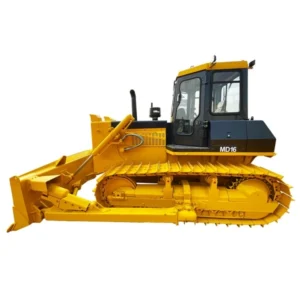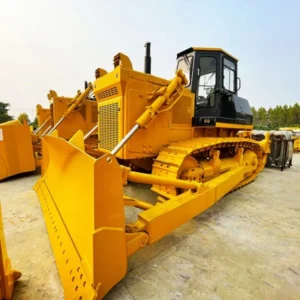Introduction
In the construction industry, the size of the equipment used can significantly influence the efficiency and overall cost of a project. Bulldozers, in particular, come in various sizes, each suited to different types of tasks and project scales. Understanding how bulldozer sizes impact construction efficiency and costs is crucial for project managers and contractors looking to optimize their operations. This comprehensive guide explores the various aspects of bulldozer sizes and their implications on construction projects.
The Importance of Bulldozer Sizes in Construction

Understanding Bulldozer Sizes
Bulldozers are categorized into different sizes based on their horsepower, weight, and blade dimensions. The primary categories include small, medium, and large bulldozers, each designed for specific types of tasks and terrains.
- Small Bulldozers: Typically range from 80 to 150 horsepower and are used for tasks such as residential site clearing, grading, and small-scale landscaping.
- Medium Bulldozers: Generally have 150 to 250 horsepower and are suitable for mid-sized construction projects, including road building and infrastructure development.
- Large Bulldozers: Boast over 250 horsepower and are designed for heavy-duty tasks such as mining, major earthmoving, and large-scale construction projects.
Role of Bulldozer Sizes in Project Efficiency
The efficiency of a construction project can be greatly affected by the size of the bulldozer used. Smaller bulldozers offer maneuverability and precision, making them ideal for tight spaces and detailed work. Medium-sized bulldozers balance power and flexibility, while large bulldozers provide unmatched power and capacity for significant earthmoving tasks.
Factors Influencing the Choice of Bulldozer Sizes
Project Scope and Requirements
The scope and requirements of a project are the primary determinants of the appropriate bulldozer size. Large-scale projects with extensive earthmoving needs will benefit from larger bulldozers, while smaller projects or those requiring detailed work will be better served by smaller models.
Terrain and Soil Conditions
The terrain and soil conditions of the construction site also play a crucial role in selecting bulldozer sizes. Rocky, uneven, or challenging terrains may necessitate the use of more powerful, larger bulldozers that can handle difficult conditions. Conversely, flat and soft terrains might be managed efficiently with smaller bulldozers.
Budget Constraints
Budget constraints are always a consideration in construction projects. Larger bulldozers, while more powerful, come with higher operational costs, including fuel consumption, maintenance, and transportation. Smaller bulldozers are more economical but may require more time to complete larger tasks, potentially increasing labor costs.
Comparing Bulldozer Sizes: Efficiency and Costs
To better understand how bulldozer sizes impact efficiency and costs, we compare small, medium, and large bulldozers across various parameters.
| Parameter | Small Bulldozers | Medium Bulldozers | Large Bulldozers |
|---|---|---|---|
| Horsepower | 80-150 HP | 150-250 HP | 250+ HP |
| Typical Applications | Residential clearing, landscaping | Road building, infrastructure | Mining, major earthmoving |
| Fuel Consumption | Low | Moderate | High |
| Operational Costs | Low | Moderate | High |
| Maneuverability | High | Moderate | Low |
| Productivity | Low to moderate | High | Very high |
| Initial Cost | Low | Moderate | High |
Efficiency Analysis
- Small Bulldozers: Offer high maneuverability and low operational costs, making them ideal for smaller projects and tasks requiring precision. However, their productivity is lower compared to larger bulldozers.
- Medium Bulldozers: Provide a balance between power and flexibility, making them suitable for a wide range of projects. They offer higher productivity than small bulldozers while maintaining manageable operational costs.
- Large Bulldozers: Deliver unmatched power and productivity, essential for large-scale projects. However, their high fuel consumption and operational costs can be a significant drawback.
Cost Analysis
- Initial Cost: Large bulldozers have a higher initial purchase cost compared to small and medium bulldozers. This can be a barrier for smaller contractors or projects with limited budgets.
- Fuel and Maintenance: Larger bulldozers consume more fuel and require more extensive maintenance, leading to higher ongoing costs. Small and medium bulldozers are more economical in terms of fuel and maintenance.
- Labor Costs: While larger bulldozers can complete tasks faster, potentially reducing labor costs, smaller bulldozers might require more time, increasing labor expenses.
Case Study: Impact of Bulldozer Sizes on a Construction Project

Project Overview
A mid-sized construction company was tasked with developing a new residential area, including site clearing, road construction, and landscaping. The project required the use of bulldozers of different sizes to handle various tasks efficiently.
Bulldozer Utilization
- Small Bulldozers: Used for initial site clearing and detailed landscaping work around residential plots. Their maneuverability allowed for precision in tight spaces.
- Medium Bulldozers: Employed for road construction and infrastructure development. They balanced power and flexibility, making them ideal for the varied tasks of the project.
- Large Bulldozers: Utilized for major earthmoving tasks, such as preparing the foundation for large buildings and moving significant volumes of soil and rock.
Results
The strategic use of bulldozers of different sizes optimized the project’s efficiency and costs. Small bulldozers handled detailed work effectively, medium bulldozers ensured timely road construction, and large bulldozers expedited major earthmoving tasks. This approach minimized downtime and balanced operational costs, contributing to the project’s overall success.
Conclusion: Bulldozer Sizes
Choosing the right bulldozer size for a construction project is crucial for optimizing efficiency and controlling costs. By understanding the strengths and limitations of small, medium, and large bulldozers, project managers can make informed decisions that enhance productivity and ensure budget adherence. The impact of bulldozer sizes on construction efficiency and costs underscores the importance of careful planning and equipment selection in the construction industry.
FAQ
What factors should I consider when choosing a bulldozer size for my project?
When choosing a bulldozer size, consider the project scope, terrain and soil conditions, budget constraints, and specific task requirements. These factors will help determine the most suitable bulldozer size for optimal efficiency and cost-effectiveness.
How do small bulldozers differ from large bulldozers in terms of efficiency?
Small bulldozers offer high maneuverability and are ideal for precision tasks in tight spaces, but they have lower productivity compared to large bulldozers. Large bulldozers provide unmatched power and productivity, essential for large-scale tasks, but they come with higher operational costs.
Can using the wrong bulldozer size impact project costs?
Yes, using the wrong bulldozer size can significantly impact project costs. A bulldozer that is too small may increase labor costs and project duration, while an oversized bulldozer can lead to higher fuel consumption and maintenance costs.
Are medium bulldozers a good compromise between small and large models?
Yes, medium bulldozers offer a balance between power and flexibility, making them suitable for a wide range of construction tasks. They provide higher productivity than small bulldozers while maintaining more manageable operational costs compared to large models.
How does terrain affect the choice of bulldozer size?
Terrain plays a crucial role in determining the appropriate bulldozer size. Rocky, uneven, or challenging terrains may require more powerful, larger bulldozers, while flat and soft terrains might be efficiently managed with smaller bulldozers.
What are the operational costs associated with large bulldozers?
Operational costs for large bulldozers include higher fuel consumption, more extensive maintenance, and increased transportation expenses. These factors contribute to the overall higher cost of operating large bulldozers.
Can bulldozer size affect the quality of work on a construction site?
Yes, the size of the bulldozer can affect the quality of work. Smaller bulldozers offer precision and are ideal for detailed tasks, while larger bulldozers are better suited for heavy-duty tasks that require significant power and capacity.
How can I ensure I am using the right bulldozer size for my project?
To ensure you are using the right bulldozer size, conduct a thorough assessment of your project’s requirements, including task type, terrain, budget, and operational goals. Consulting with equipment experts and analyzing previous project data can also aid in making the right choice.
What are the environmental considerations when choosing bulldozer sizes?
Environmental considerations include fuel efficiency and emissions. Smaller bulldozers generally consume less fuel and produce fewer emissions, while larger bulldozers may have a greater environmental impact due to higher fuel consumption and emissions.
How do bulldozer sizes impact project timelines?
The size of the bulldozer can impact project timelines by affecting the speed and efficiency of task completion. Larger bulldozers can complete tasks faster, potentially reducing project duration, while smaller bulldozers might require more time, extending the project timeline.







-150x150.webp)
